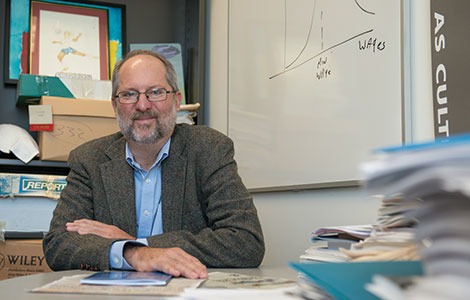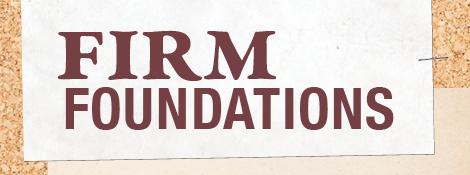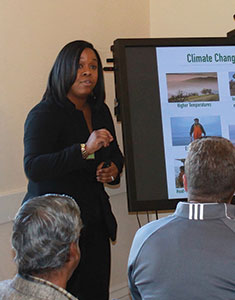Safety First
It happened at Target. It happened at JPMorgan Chase. It happened at the federal Office of Management and Budget (OMB). Hackers have relentlessly pilfered millions of social security numbers, financial records, and fingerprints, opening an abyss of anxiety about the future of privacy in a digital age.
For Richard Forno, the director of UMBC’s graduate program in cybersecurity, each new computer breach is a testament to human folly.
“The OMB hack hit close to home,” he says. “My information was there. My fingerprints were there.”
Before arriving at UMBC in 2010, Forno worked for nearly two decades as a cybersecurity consultant for private firms and government agencies. He says many organizations still ignore simple warnings laid down as long ago as the mid-1990s. (One example: If you use Social Security numbers as a primary method for identifying your employees or customers, you’re begging for trouble.)
“We’re still dealing with folks cutting corners in securing private information,” Forno says. “We see a lot of task forces and commissions – but when you look at what they actually recommend to improve federal cybersecurity, many of those recommendations are rehashes of ideas that go back into the 90s. Here we are twenty years later, still talking about basic security practices that are not being followed.”
It is alarming, Forno says, that until very recently the U.S. Department of Defense continued to use Social Security numbers to identify employees. “They’re finally moving away from that,” he says. “But with an organization of that size, it won’t be an easy process.”
Some people have hoped that IDs and passwords can be replaced with biometric systems such as fingerprints or iris scans. But those solutions have difficulties of their own. “We need to think carefully about the tradeoffs,” Forno says. “Will all of this biometric data be stored in a central database that the next generation of hackers will target?”
Forno believes that UMBC and other universities play a crucial role in strengthening cybersecurity theory and practice. He says UMBC is well positioned to bring together technically trained computer scientists with scholars from the humanities and social sciences. Only by combining those domains, he argues, will we be able to foresee emerging threats and train firms and agencies to prevent them.
“We have people who are extremely gifted technically,” Forno says. “But the skills and expertise of non-computer scientists can be just as valuable. You don’t need to be a hardcore geek.”
Forno’s graduate program awards over a hundred master’s degrees each year, mostly to midcareer professionals. And as assistant director of the UMBC Center for Cybersecurity, a campus-wide interdisciplinary project, Forno and his colleagues organize workshops, seminars, and lectures for broader audiences at UMBC. He also serves as a faculty adviser to the CyberDawgs, a student team that has been highly successful in national cyber war game events. (The 2014-2015 team made it to the national finals.)
“If you come out of UMBC,” Forno says, “I want you to know the basics. How to secure your wireless network, your cell phone, how to conduct good social media practices, so that you’re not easily becoming a victim. That’s the long-term goal.”
— David Glenn
Living (With) Wages
Ever since the financial crisis of 2008 hammered the global economy, rising income inequality – and how to combat it – has been much on the mind of the world’s politicians and policymakers.
But long before 2008, those issues were already on the mind of Tim Gindling, who has spent the last fifteen years researching minimum wage policy impacts in Latin America, and he has recently expanded his research to look at policies in other developing countries such as China. In almost every case, he has found that there is not a simple one-to-one relationship that suggests raising minimum wages automatically reduces poverty.
A professor of economics at UMBC, Gindling became interested in the issue during a year spent as a researcher at the University of Costa Rica. He discovered that minimum wage policy is the most visible policy affecting the distribution of wages in countries like Costa Rica, Nicaragua, Honduras, and El Salvador. His research findings also have inspired governments in developing countries to enact changes to minimum wage regulations.
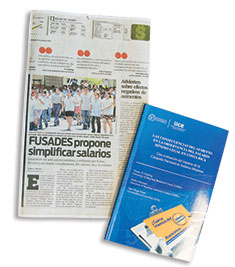
In a May 2014 article published in the journal, IZA World of Labor, Gindling argued that in most cases, a rise in the minimum wage usually reduces poverty. But the direct positive or negative impacts are difficult to measure. A number of factors – including its effect on higher-paid workers, non-compliance, and a lack of social safety nets to protect workers who lose their jobs – can reduce its effect.
Gindling also found that when minimum wages are increased in Latin American developing countries, many workers at the bottom of the scale do not reap benefits because they are self-employed.
“One reason it’s not a simplistic issue is the fact that when you raise the minimum wage in a developing country, you aren’t raising the wage of the poorest workers because the poorest workers are in this unorganized, informal sector,” explains Gindling. “Rather, higher
minimum wages affect the wages of people who are in the formal sector who tend to be near the middle of the income distribution.”
Gindling’s work also helped affect policy in countries he has studied. Although raising minimum wages helps workers in certain sectors of the economy, Gindling and his colleagues discovered that refusal by some employers to pay minimum wage means that even formal sector workers are often not paid what they should be.
“In almost every country we’ve looked at in Latin America, there’s a high degree of non-compliance,” he says. “We’ve brought this to the attention of policymakers when we can. The work we did in Costa Rica was part of what encouraged the government to implement a comprehensive program to improve compliance, including an extensive public relations campaign, increased fines, and inspections.”
Gindling hopes his ongoing work will continue to inform policy discussions and inspire broad coalitions to address a complicated issue with global implications for growth.
— Max Cole
Let There Be Light
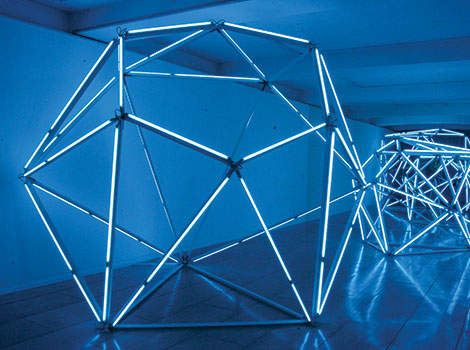
Illumination has always been an important part of Baltimore history. One of the city’s most famous early museums – created by Rembrandt Peale in 1814 – was lit by gas lamps. Peale’s new gas company also ensured that Baltimore was the first U.S. municipality lit by gas lamp in 1817.
That legacy of light in Baltimore is part of the inspiration for the inaugural Light City Baltimore
festival. The event – held from March 28 to April 3 – will be the first large-scale light festival in the United States and celebrate Baltimore’s status as a hub of creativity and innovation.
Light City’s centerpiece will be a 1.5-mile art walk around Baltimore’s Inner Harbor, showcasing light
displays, interactive installations, and projections – accompanied by music and dance performances at two stages.
Creative works by UMBC alumni and faculty will have a strong presence at Light City – and the university is a founding sponsor of the festival, reflecting UMBC’s strong ties to the city. At night, while the city is lit up by the festival, UMBC will host a Black and Gold Lounge inside the Columbus Center – where alumni and friends of the university can warm up with a hot beverage and reconnect with other members of the UMBC community.
The university is hosting a daytime conference associated with the festival (Light City U) that will allow participants to explore the innovations that power social change. UMBC President Freeman A. Hrabowski, III, will give a keynote address, and Light City U will also offer workshops and hackathons on sustainability, health care, education, and the city’s creative industries.
UMBC will also have a strong presence on the art walk – not surprising given the university’s strength in marrying art and new technology. Symmes Gardner, director of UMBC’s Center for Art, Design and Visual Culture, will exhibit a video installation titled “1,001 Lux.” And UMBC associate professors of visual arts Kelley Bell, M.F.A. ’06, imaging and digital arts, and Corrie Parks will display a new work, “Project Aquaculture,” at the Columbus Center.
“Baltimore is shedding light on itself through media, social action, and art,” says Colette Searls, the chair of UMBC’s theatre department and another Light City exhibitor. “The festival emphasizes Baltimore as a generator of great art and a destination for lovers of great art.”
In collaboration with Lynn Tomlinson, who teaches digital media at Towson University, Searls will be exhibiting a work that combines animation, live theater, and puppetry featuring a crab named Kendra. The crab, controlled by Searls through a computer touch screen, addresses the conflict between society’s environmental concerns and its continuing reliance on throw-away objects.
In a different part of the art walk, Mina Cheon, M.F.A. ’02, digital arts, and her architect husband, Gabriel Kroiz, have created a display of 15 giant LED diamonds that will seem to tumble toward the water.
“Artistically, innovatively, I’m just so excited to have the opportunity to do this,” says Cheon. “In terms of impact, I hope it really changes the impression of Baltimore.”
— Bess Keller
For more information on the festival go to lightcity.org.
Past Present
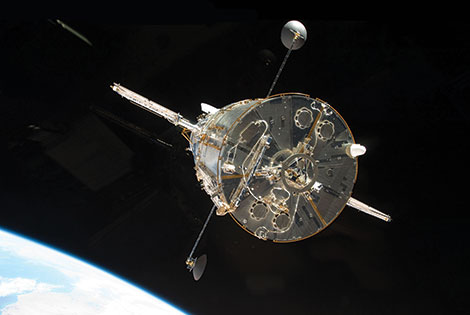
Astronomers at UMBC have seen a rare cosmic event: A gigantic stream of plasma, all lit up as it shoots from around a black hole in another galaxy at nearly the speed of light.
The work was done with the Hubble Space Telescope by Eileen Meyer, assistant professor of physics, and Markos Georganopoulos, associate professor of physics, and a team at the Space Telescope Science Institute – which is operated by the Association of Universities for Research in Astronomy for NASA.
The researchers created a time-lapse video over a 20-year period and spotted the event – an observation almost without precedent. They published their finding in Nature in the spring.
The action they saw is occurring in an elliptical galaxy, NGC 3862, which is 260 million light years from us. It is an event that actually occurred when dinosaurs roamed the earth. By astronomical terms, however, NGC 3862 is one of our neighboring galaxies and 260 million light years is the day-before-yesterday.
Most galaxies have black holes in their center – massive objects where the gravity is so strong nothing escapes, not even light. Each also has an edge, the event horizon, an area beyond which everything nearby gets sucked in.
Outside the event horizon are so-called accretion disks, collections of gas and dust that swirl around the black hole like water circling a drain. Unlike the water in the drain, however, not all the material eventually flows into the black hole. Sometimes – and astronomers still don’t know why – some of this material blasts out in the form of jets of plasma, or ionized gas.
Each of the jets has very little density, and they are being hurled at relativistic speeds, which means within a percentage or two of the speed of light.
Oddly, the images the scientists gathered make it look as if the jet was going seven times faster than the speed of light, but scientists think that’s impossible. Georganopoulos says it is likely an optical illusion called “superluminal motion,” — which happens when something is coming almost directly toward an observer at nearly the speed of light.
 The material in the jet is ejected at varying speeds and forms blobs that look like pearls on a string, the bright lights detected by Hubble.
The material in the jet is ejected at varying speeds and forms blobs that look like pearls on a string, the bright lights detected by Hubble.
The brightness is created by some of the blobs, moving faster than others, rear-ending blobs in front of them. The kinetic energy of the collision is transferred to light.
“You can see it before it slows down, but the collision seems to make the blobs brighter,” says Meyer.
The exact same thing happens on the other side of the black hole, but it can’t be seen from Earth.
“We’ve never seen two components of a jet colliding,” says Georganopoulos.
The finding is exciting for many reasons, not least of which is that it is rare to observe anything moving outside of our own Milky Way galaxy. Such jets of plasma normally only show up at radio wavelengths. The jets in NGC 3862 were observed in the visual wavelength. Moreover, using time lapse photography, they were seen moving.
— Joel N. Shurkin
Tags: Winter 2016


